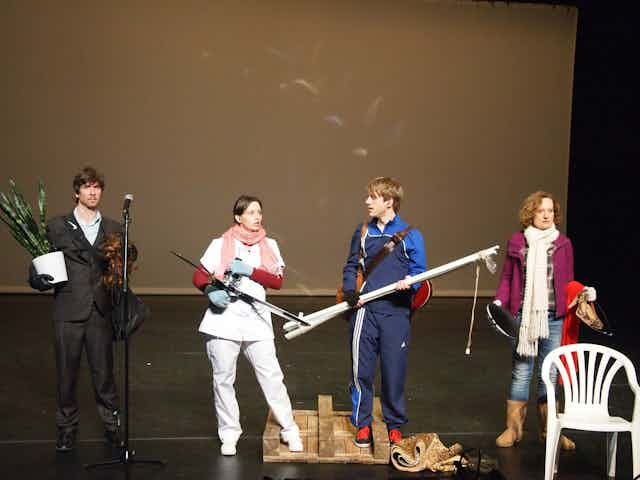The rules of Cadavre Exquis are basic.
Four directors, each responsible for 15 minutes of material. Each brings one actor. This is the basis of Cadavre Exquis, a performance staged at Sydney’s Carriageworks as part of the Sydney Festival.
The director of the first sequence returns to create the final 15 minutes, the cast working with each director in sequence, sworn to secrecy; each director was only allowed to see the final 60 seconds of the previous installment.
Out of this emerges a 75-minute performance pitched as “an experiment” in the spirit of the Cadavre Exquis (exquisite corpse), claimed by French poet Andre Breton as an invention of the Surrealists, better known as a children’s game, “consequences” – in which a story is co-created by a series of contributors, each ignorant of what has already transpired.
The Surrealists used the technique to produce monstrous figures, each artist producing a body part – torso, legs, head – without knowing what the others had done, or would do. The result can be fantastical: dream - or nightmare creatures; Frankensteinian fantasies, impossible, monstrous hybrids.
DIY cadavre exquis
Google “cadavre exquis”, and select “images”.
The joke turns not so much on the individual parts of the composition, nor the unlikely emergent juxtapositions, absurd turns and grotesqueries. What makes the exquisite corpse is the dissonance between the arbitrariness of the composition and its overall fidelity to the form of a body; most frequently a human body.
Without that fidelity, against which the desired absurdity and surrealism can unfold, you are left with mere doodles, and there is, of course, nothing wrong with that. It is, however, the implicit rule — that a body is being created, and that that body has a particular set of default values, a particular form — that elevates the cadavre exquis beyond monstrous miniature.

Cadavre Exquis at Carriageworks
The set up for the staged Cadavre Exquis – the first act, as it were – was a short film. A screen divided into quadrants, each offering the point of view of a single character, each added, sequentially, through an encounter with the others.
First a woman, waking, applying make-up, leaving her apartment, encounters a suited man in the elevator. His point of view, introduced by a careful, slow pan up and down the length of the woman’s body, is added to the screen. They board a train, sharing a seat with another woman in a nurse’s uniform.
All three then meet a sportswear-clad man in a park. Together they walk through a drab landscape, accumulating various objects. A pallet. A ceiling fan, a venetian blind. The first woman lifts a pair of shoes from a display window. A snake plant, uprooted from a field; a pot for the snake plant.
They come to a facility of some kind, scale a fence, kick down a door and stand, staring … a massive digital clock appears, superimposed on the screen, counting down from 60 seconds. The characters stand, not moving, staring …
This, then, is the first director’s offer: a motley ensemble, none of whom have, yet, spoken, accompanied by an arbitrary collection of objects, an absolutely nondescript location. They are not doing anything. It’s like a still from an undiscovered film by Ionescu: characters in search of … something. Anything.
Now the booty-bearing performers enter, to laughter.
They stand across the front of the stage. The house lights come up: some low level clowning, a degree of mugging at the audience.
At last we get some words: a pastiche of what sounds to me like verbatim grabs from rehearsal. It becomes a slightly earnest exercise in metatheatricality: lots of talk of catharsis, character (should we have one?), musings on dei ex machinae.
Not much happens. More Ionescu, a dash of Beckett as we wait and wait.
We are, I fear, attendant at something like an autopsy, picking over a not so exquisite cadaver.
More generously, perhaps I could say that we are witness to the brave performance of a paralysing anxiety at the heart of the process, the deus ex machina invoked as a plea for salvation: get us out of here.
The third sequence takes up a series of imprecations to absent deities, culminating in a rather lame call out to Michael Jackson, climaxing in manic activity as a recording of actor Christian Bale savaging a hapless director and crew (a viral hit a few years back). A string of carnival lights is draped upstage, the performers perform a boot-scooting line dance.

An hour in, and the penultimate director, having arranged for the carnival lights to be taken down (so much for that offer/provocation) marshals the cast into a dance sequence for the entirety of the 15 minutes: a slamming, high-intensity krumpfest, each performer taking up one of the various props in turn, swirling it, wielding it, whooping it up.
Last, the first director returns. A blue background, bird squawk sound effects at last establish a place: we are on the water; the final sequence consists in a task-based playing out of assembling—salvaging—the disparate objects on the pallet, now a raft.
A stage hand enters with a pallet jack and takes the whole thing away. The cast exit, waving back to us, reappearing briefly on screen, back on location, still reluctantly farewelling, and it’s over.
The problem is that the absence of a commitment to a form yields a kind of conceptual void. A few gags along the way, but nothing substantial, few insights. Under conditions of the post-dramatic—the refusal of genre, form, narrative, convention—there is not much with which to play; nothing against which to react; nothing to learn.
An experiment? Well …
Cadavre Exquis played at Carriageworks as part of the Sydney Festival. More details here.
Visit the University of Sydney’s festival hub here.

